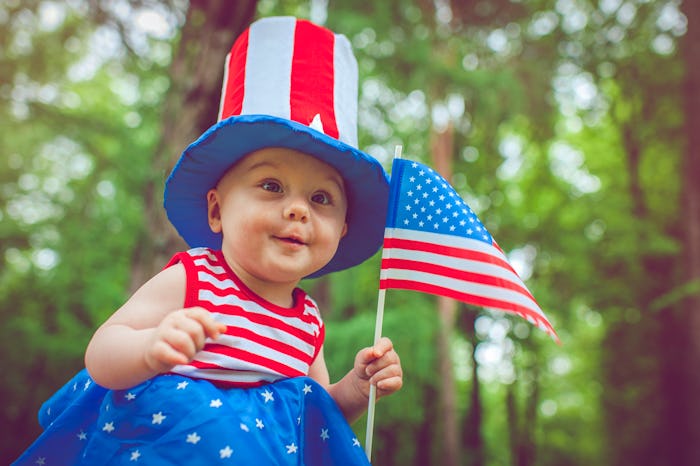Independence Day

You Can Totally Share 4th Of July Fireworks With Your Baby
It’s all about protecting those little ears.
It's exciting to create new family traditions with your little ones, and as the 4th of July rolls around, you might be thinking about taking your babies to the fireworks show. Fireworks to celebrate America are a time-honored tradition, and it's no wonder you want to include those closest to you. Kids, for the most part, love fireworks, but is it safe to take a baby to see fireworks? There are a few things to consider before you make your decision.
How Fireworks Can Affect Your Baby
“Fireworks can definitely be very startling for babies due to the loud sound,” Nicole Aaronson, MD, MBA, CPE, FAAP, FACS, Pediatric Otolaryngologist at Alfred I. duPont Hospital of Children, tells Romper. “Because babies have particularly narrow ear canals, the pressure wave generated by the sound of fireworks can be uncomfortable/painful for their ears as compared to the ears of an older child or an adult.” In fact, babies simply don’t experience sound the same way that adults do. “What a baby hears can sound up to 20 decibels louder than adults,” Dr. Shawn Nasseri, Mayo Clinic-trained ENT surgeon, tells Romper. “Generally you want to keep sounds quieter than 60 decibels.” The average Fourth of July celebrations aren’t exactly baby-friendly, then. “Fireworks are way above a safe range, into 150 to 175 decibel range,” says Nasseri.
Also, fireworks shows aren’t necessarily fun for all babies. Jon Saltzman, a paramedic for ParaDocs Worldwide, works a lot of 4th of July events, and he offered some advice — keep your babies home. "Young children and babies don’t always appreciate the loud explosions," he tells Romper.
Can Fireworks Damage A Baby’s Hearing?
“Yes, it could result in slight temporary hearing loss, tinnitus — ringing in the ears — or eardrum perforation,” says Nasseri. “Infant hearing is very sensitive and can be easily damaged by loud sounds.” Although a single exposure to loud noise will not necessarily cause lasting damage to a baby’s hearing, “sounds higher than 85 dB can theoretically be damaging to hearing,” says Aaronson.
How can you safely watch fireworks with your baby?
It’s not always feasible to leave baby at home, and if the whole family is going out for the holiday, there are ways to keep everyone safe. In short, ear protection is everything. “I recommend carrying your baby in a carrier and covering their ears to muffle the sound of the fireworks. You can cover their ears with baby hearing protection earmuffs,” says Nasseri. If your baby will tolerate it, over-the-ear headphones are a good choice, says Aaronson.
Your distance from a fireworks show also makes a difference. “Children should be 150 to 200 feet away from fireworks. Ideally a baby can be about 500 feet away from the fireworks so they can still be seen and enjoyed without the negative sound effects,” says Aaronson.
If it’s a backyard celebration, then watch from the windows. “It's best to keep infants indoors as they have hyper sensitive hearing,” Julie L. Heckman, Executive Director of the American Pyrotechnics Association (APA), tells Romper. Let adults brave the elements outside while your baby gets to hang out in the home.
It's best to always have a backup plan in case your best intentions don't work out as planned. Pack some ear protection, but be prepared to pop into the car if baby needs some extra muffling.
Experts:
Nicole Aaronson, MD, MBA, CPE, FAAP, FACS, Pediatric Otolaryngologist, Alfred I. duPont Hospital of Children, Assistant Clinical Professor of Otolaryngology and Pediatrics, Thomas Jefferson Sidney Kimmel School of Medicine
Julie L. Heckman, Executive Director of the American Pyrotechnics Association (APA)
Dr. Shawn Nasseri, Mayo Clinic trained Ear, Nose and Throat Surgeon
Jon Saltzman, a paramedic for ParaDocs Worldwide
This article was originally published on